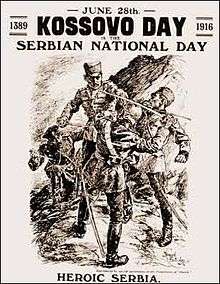Vidovdan
Vidovdan (Serbian Cyrillic: Видовдан, "St. Vitus Day") is a Serbian national and religious holiday, a slava (feast day) celebrated on 28 June (Gregorian calendar), or 15 June according to the Julian calendar. The Serbian Church designates it as the memorial day to Saint Prince Lazar and the Serbian holy martyrs who fell during the Battle of Kosovo against the Ottoman Empire on 15 June 1389 (according to the Julian calendar). It is an important part of Serb ethnic and Serbian national identity.[1]
| Vidovdan | |
|---|---|
Vidovdan celebration at Gazimestan monument (2009) | |
| Observed by | Serbs (Serbian Orthodox) |
| Observances | Feast day |
| Date | 28 June (Gregorian calendar) 15 June (Julian calendar) |
| Frequency | annual |
| Related to | Slava |
Events

Vidovdan, 15 June Julian (equivalent to 28 June Gregorian in the 20th and 21st centuries), is considered a date of special importance to the Serbian people (Serbs), with the following events taking place on Vidovdan, but are expressed here in the Gregorian calendar:
- 1389: the Ottoman army fought[2][3][4][5][6] the Serbian army in the Battle of Kosovo on the Kosovo field. Both Sultan Murad and Prince Lazar were slain in battle. The Kosovo Myth became important in forming Serbian identity.[7]
- 1876: Serbian declaration of war against the Ottoman Empire (Serbian–Ottoman War (1876–1878)).
- 1914: the assassination of the Austro-Hungarian crown prince, Franz Ferdinand by Gavrilo Princip; triggers the First World War. It was a coincidence that the archduke visited Sarajevo on that day, but the assassination falling on Vidovdan added nationalist symbolism to the event.[8]
- 1916: Radomir Vešović and other notable Montenegrin officers planned an uprising in Montenegro, against the Austro-Hungarian occupying forces.[9]
- 1919: the Treaty of Versailles is signed ending World War I.[10]
- 1921: the Serbian King Alexander I proclaims the new Constitution of the Kingdom of Serbs, Croats and Slovenes, known thereafter as the Vidovdan Constitution (Vidovdanski ustav).[11]
- 1948: the Cominform publishes, on the initiative of its Soviet delegates Zhdanov, Malenkov and Suslov, in a "Resolution on the State of the Communist Party of Yugoslavia"[12] their condemnation of the Yugoslavian communist leaders – this event is seen as the turning point that marks the final split between Stalin's Soviet Union and Tito's Yugoslavia. The date was carefully chosen by the Soviets as it was an important anniversary.[13]
- 1989: on the 600th anniversary of the battle of Kosovo, Serbian leader Slobodan Milošević delivers the Gazimestan speech on the site of the historic battle.[14]
- 1990: an amendment is brought to the Constitution of Croatia changing the status of Serbs from constituent people (konstitutivni narod) of the Croatian nation to national minority.
- 2001: Slobodan Milošević is deported to the ICTY to stand trial.[15]
- 2006: Montenegro is announced as the 192nd member state of the United Nations.[16]
- 2008: the inaugural meeting of the Community Assembly of Kosovo and Metohija takes place.[17]
- 2018: the formal reopening of the National Museum of Serbia in Belgrade, after 15 years of renovation.[18]
References
Citations
- Đorđević 1990.
- Emmert, Thomas Allan (1990). Serbian Golgotha: Kosovo, 1389. East European Monographs. ISBN 978-0-88033-175-3.
- Daniel Waley; Peter Denley (2013). Later Medieval Europe: 1250–1520. Routledge. p. 255. ISBN 978-1-317-89018-8. ""
- Ian Oliver (2005). War and Peace in the Balkans: The Diplomacy of Conflict in the Former Yugoslavia. I.B.Tauris. p. vii. ISBN 978-1-85043-889-2.
- John Binns (2002). An Introduction to the Christian Orthodox Churches. Cambridge University Press. p. 197. ISBN 978-0-521-66738-8. "The battle is remembered as a heroic defeat, but historical evidence suggests an inconclusive draw."
- John K. Cox (2002). The History of Serbia. Greenwood Publishing Group. p. 30. ISBN 978-0-313-31290-8. "The Ottoman army probably numbered between 30,000 and 40,000. They faced something like 15,000 to 25,000 Eastern Orthodox soldiers. [...] Accounts from the period after the battle depict the engagement at Kosovo as anything from a draw to a Christian victory."
- Isabelle Dierauer (16 May 2013). Disequilibrium, Polarization, and Crisis Model: An International Relations Theory Explaining Conflict. University Press of America. p. 88. ISBN 978-0-7618-6106-5.
- Manfried Rauchensteiner, Der Erste Weltkrieg und das Ende der Habsburgermonarchie 1914–1918, 2013, p. 87
- (Rakočević 1997, p. 313)
- Treaty of Versailles Signatures and Protocol
- Robert J. Donia, John Van Antwerp Fine; Bosnia and Hercegovina: A Tradition Betrayed. Columbia University Press, 1995. (p. 126)
- "Resolution of the Information Bureau Concerning the Communist Party of Yugoslavia, June 28, 1948". Modern History Sourcebook. Fordham University. Retrieved 26 June 2017.
- Ramet 2006, p. ?.
- The Kosovo Conflict and International Law: An Analytical Documentation 1974–1999, ed. Heike Krieger, pp. 10–11. Cambridge University Press, 2001; ISBN 0-521-80071-4. online version in Milošević's official website
- "Milosevic extradited". BBC News. 28 June 2001. Retrieved 3 March 2014.
- "GENERAL ASSEMBLY APPROVES ADMISSION OF MONTENEGRO TO UNITED NATIONS, INCREASING NUMBER OF MEMBER STATES TO 192". United Nations. 28 June 2006. Retrieved 26 June 2017.
- "Kosovo Serbs launch new assembly". BBC News. 28 June 2008. Retrieved 28 June 2008.
- "Reopening of national museum in Belgrade". The Associated Press. 28 June 2018. Retrieved 28 June 2018.
Sources
- Đorđević, Dimitrije (Spring 1990). "The role of St. Vitus Day in modern Serbian history" (PDF). Serbian Studies. North American Society for Serbian Studies. 5 (3): 33–40.CS1 maint: ref=harv (link)
- Šijaković, Bogoljub. "The Great War, ethics of Vidovdan, memory." Zbornik Matice srpske za drustvene nauke 150 (2015): 1–42.
- Rakočević, Novica (1997). Crna Gora u prvom svjetskom ratu, 1914–1918. Unireks.CS1 maint: ref=harv (link)
External links
| Wikimedia Commons has media related to Vidovdan. |
- News articles
- "What is Vidovdan, and why is it so important to Serbs?". B92. 22 June 2012.
- "Serbian War Vets Celebrate Vidovdan". Balkan Insight. 29 June 2012.
- Graham, Stephen (1930). St. Vitus Day. E. Benn.
